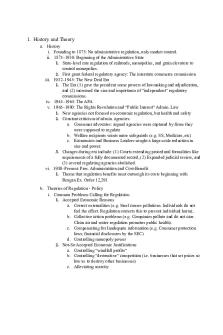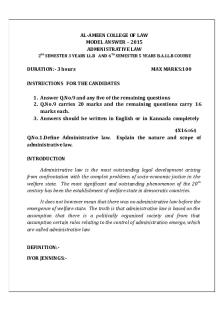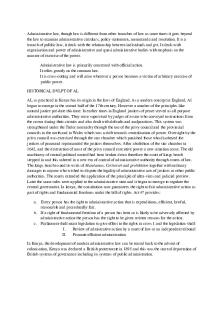Administrative Law Wk 1 outline PDF

| Title | Administrative Law Wk 1 outline |
|---|---|
| Course | Administrative Law |
| Institution | University of Western Australia |
| Pages | 6 |
| File Size | 201.7 KB |
| File Type | |
| Total Downloads | 97 |
| Total Views | 168 |
Summary
Download Administrative Law Wk 1 outline PDF
Description
Administrative Law LAWS5102 Topic 1: Introduction to Administrative Law; nature and function of judicial review Outline Introduction to the unit Intro to Administrative Law What is administrative law? Historical overview Challenges for administrative law Judicial Review What is judicial review? Reviewable decisions Jurisdiction Teaching Team Julie Falck – Unit Coordinator, lectures, tutorials ◦ Office hours: 10am-12pm Tuesdays, Law Link Building Rm 1.38 ◦ [email protected] Ambelin Kwaymullina – lectures on procedural fairness (Weeks 3 & 4) ◦ [email protected] Alex Gardner – lectures on remedies (Weeks 10 & 11) ◦ [email protected] Natalie Brown – tutorials ◦ [email protected] Unit Information LMS – check regularly for announcements ◦ Library Workshops week 5 Unit Outline, Reading Guides, Powerpoints Text ◦ Creyke, McMillan & Smyth, Control of Government Action: Text, Cases and Commentary, 4th edition, 2015 Assessment Tutorial participation (10%) ◦ Assessed by your tutor throughout the semester ◦ Research essay (30%) ◦ Question and instructions to be released by end Week 2 on LMS ◦ Due 27 September, submitted through LMS ◦ Exam (60%) ◦ 2 hr open book exam in Semester 2 examination period ◦ Final lecture will be exam revision session
Administrative Law
What is Administrative Law? Deal with power and control “the body of principles and procedures by which the exercise of executive government power is controlled and supervised” ◦ Lane & Young, p 1 “about how administrative power is constituted and controlled by law” ◦ Cane, McDonald & Rundle, p 1 “with power comes responsibility and accountability” ◦ Creyke, McMillan & Smyth, p 3
What is Administrative Law? “Defining administrative law is a topic on which few commentators can reach agreement, because it ultimately depends on what they want out of administrative law. We know what we want. As a minimum, we want a legal system which addresses the ideals of good government according to law. We take those ideals to include openness, fairness, participation, accountability, consistency, rationality, accessibility of judicial and non-judicial grievance procedures, legality and impartiality.” ◦ Aronson, Groves & Weeks, pp 3-4
Concepts to Review Separation of Powers Rule of Law Responsible Government Federalism
Core Components Judicial Review – define categories of legal error Merits Review – impartial reconsideration of government decisions Freedom of Information Ombudsman
History of Administrative Law in Australia Origins in judicial review Developments in Australia ◦ Kerr, Bland and Ellicott Committees ◦ Federal framework: ◦ Administrative Appeals Tribunal Act 1975 (Cth) ◦ Ombudsman Act 1976 (Cth) ◦ Administrative Decisions (Judicial Review) Act 1977 (Cth) ◦ Freedom of Information Act 1982 (Cth) ◦ WA framework: ◦ Parliamentary Commissioner Act 1971 (WA)
◦ ◦ ◦ ◦
Freedom of Information Act 1992 (WA) State Administrative Tribunal Act 2004 (WA) Purposes and Interests
Challenges for Administrative Law Changing nature of government Privatisation/corporatisation/outsourcing Working with administrative law in Australia
Judicial Review What is judicial review? ◦ “the means by which courts determine whether or not administrative bodies and officials have properly respected the boundaries of the powers and functions formally assigned to them” (L&Y p 1) – judicial review is confined to decide the pubic bodies have acted lawfully, but not to consider the merit of the decision the court cannot substitute the lawful decision they think would be preferable ◦ send back to the executive to decide again based on the court advice, make the decision again, but can make the same decision. But not to substitute the decision ◦ if no legal error in the decision, then no judicial review, but can go merit review ◦ ◦
Rule of law Separation of powers
◦
Merits/law distinction
Five elements to a successful JR challenge (CM&S p 51): ◦ 1. The person seeking redress has standing ◦ 2. The matter is justiciable (able to be reviewed by a court) ◦ 3. The court has jurisdiction or authority to review the matter ◦ 4. There is an available ground of review ◦ 5. There is an appropriate remedy
What kinds of decisions are reviewable? Basic statutory powers Prerogative/high-level powers, such as making treaty and declare war > doesn’t have statutory source Regulated by statutory by some extent but statue is not the source of power Prerogative power is reviewable
◦ ◦ ◦
R v Toohey (1981) Council of Civil Service Unions (1985) MAHE v Peko Wallsend (1987) MAHE v Peko Wallsend (1987) FFC - Exercise of prerogative power, decision by cabinet to nominate Kakadu national park for inclusion in world heritage list - Peko challenged decision concerned that listing would affect future opportunity to mine - Wilcox J: just because power is prerogative doesn’t mean it cannot be reviewed, however is there a feature of decision that makes JR inappropriate? In this case, the international relations dimension to this decision meant it shouldn’t be reviewed. Historical reluctance to review these powers however now the source of power isn’t a bar to prerogative powers being reviewed. There must be a special feature that makes decision unreviewable (e.g national security)
Quasi-public powers ◦ Datafin (1987) > read Gleeson judgement and majority judgement Datafin (1987); English Approach - Decision of panel on takeovers and mergers - Hard to work out where power came from, panel not set up by gov, it didn’t have a prerogative or statutory source of powers - Datafin complained about breach of code, panel rejected complaint - Held: panel was exercising public power and could be judicial review
- It was public because the panel operates irrespective of consent of parties, existence of the panel was part of way gov was regulation of the field, panel was recognised by statute in that it was supported and sustained by a periphery of statutory powers and penalties. - Not just looking at source of power, looking at the nature of the power ◦ NEAT Domestic Trading (2003) FACTS - Cth Wheat Marking Act established a marketing scheme whereby it was an offence to export wheat without consent of wheat marketing authority (WMA). WMA was created by the statute. - WMA couldn’t give its consent unless Australian Wheat Board International (AWBI) had given its consent. AWBI is a company owned by wheatgrowers. Private body with significant role in exercise of public power. - Neat challenged decision when it wasn’t given consent - HC said this was not reviewable, looked more to body exercising power than the nature of the power (cf Datafin)
Systems of Judicial Review General law judicial review ◦ State level ◦ Establishment of State Supreme Courts ◦ Federal level: ◦ High Court – Constitution s 75(v) ◦ Federal Court – Judiciary Act 1903 s 39B ◦ Federal Circuit Court Statutory judicial review ◦ ADJR Act (Cth) ◦ Some States (ACT, Qld, Tas) NB THERE IS NO ADJR LEGISLATION IN WA - CANNOT USE ADJR ACT IN PROBLEM QU WITH WA DECISION MAKER RE WA LAW - ADJR ACT ONLY APPLIES TO CTH LEGISLATION!!!!!! - ADJR RUNS PARALLEL TO COMMON LAW, IT DOES NOT REPLACE IT - ADJR Act has simplified remedies, and right to reasons - Reasons why you may be unable to use ADJR Act Judicial Review Jurisdiction State/Territory – general law ◦ WA Supreme Court inherited jurisdiction of superior courts of England ◦ WA SCA s 16 Federal – general law ◦ Constitution (High Court) ◦ Ss 71, 73, 75 ◦ Judiciary Act (Federal Court)
◦ ◦ ◦ ◦
S 39B(1) S 39B(1A) S 44(2A) Associated and accrued jurisdiction
Jurisdictional prerequisites (next week’s topic) ADJR Act Allows review of ◦ Decision (s 5) ◦ Conduct (s 6) ◦ Failure to make a decision (s 7) Codifies common law grounds Right to reasons (s 13) Simplified remedies (s 16)
Grounds of Review “grounds” of review = established categories of error ◦ “ultimately they are all merely expressions of the basic principle of judicial review that public authorities must exercise their powers in accordance with law” (L&Y p 101) ◦ Essentially identify what went wrong in the decision-making process Various ways of classifying (eg): ◦ Procedural grounds ◦ Reasoning process grounds ◦ Decisional grounds ◦ Next week
Jurisdictional prerequisites Tutorials start – read: ◦ NEAT Domestic Trading Pty Ltd v AWB Ltd (2003) 216 CLR 277 (Gleeson CJ judgment and joint judgment of McHugh, Hayne and Callinan JJ) ◦ Robin Creyke, “Administrative Justice – Towards Integrity in Government” (2007) 35 Melbourne University Law Review 705 ◦ Essay question released ◦ 2400 words, due 27 September...
Similar Free PDFs

Administrative Law Wk 1 outline
- 6 Pages

Administrative Law Outline
- 33 Pages

Administrative Law Outline / Summary
- 46 Pages

Administrative Law Outline
- 14 Pages

Administrative Law - Admin Law
- 6 Pages

Administrative Law - Lecture notes 1
- 48 Pages

Administrative Law - Essay
- 5 Pages

Administrative law (4th)
- 59 Pages

Administrative LAW MERITS REVIEW
- 38 Pages

Administrative Law 70617 - Essay
- 14 Pages

Administrative law Notes Kenya
- 10 Pages

Canadian Administrative Law
- 54 Pages

Administrative LAW I Notes
- 90 Pages
Popular Institutions
- Tinajero National High School - Annex
- Politeknik Caltex Riau
- Yokohama City University
- SGT University
- University of Al-Qadisiyah
- Divine Word College of Vigan
- Techniek College Rotterdam
- Universidade de Santiago
- Universiti Teknologi MARA Cawangan Johor Kampus Pasir Gudang
- Poltekkes Kemenkes Yogyakarta
- Baguio City National High School
- Colegio san marcos
- preparatoria uno
- Centro de Bachillerato Tecnológico Industrial y de Servicios No. 107
- Dalian Maritime University
- Quang Trung Secondary School
- Colegio Tecnológico en Informática
- Corporación Regional de Educación Superior
- Grupo CEDVA
- Dar Al Uloom University
- Centro de Estudios Preuniversitarios de la Universidad Nacional de Ingeniería
- 上智大学
- Aakash International School, Nuna Majara
- San Felipe Neri Catholic School
- Kang Chiao International School - New Taipei City
- Misamis Occidental National High School
- Institución Educativa Escuela Normal Juan Ladrilleros
- Kolehiyo ng Pantukan
- Batanes State College
- Instituto Continental
- Sekolah Menengah Kejuruan Kesehatan Kaltara (Tarakan)
- Colegio de La Inmaculada Concepcion - Cebu


